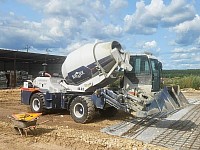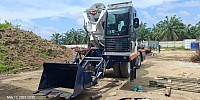FAQs of Concrete Mixers
Why On-Site Concrete Mixers Improve Efficiency and Reduce Costs
Construction professionals constantly seek ways to optimize their operations. On-site concrete mixers, including mobile concrete mixers and the concrete self-loading mixer, offer significant advantages over traditional ready-mix delivery. These machines help projects run smoother while keeping costs under control.
Immediate Availability Saves Time
Waiting for concrete deliveries often causes project delays. On-site mixers eliminate this problem completely. Workers can produce fresh concrete exactly when needed. This keeps construction schedules on track.
Key time-saving benefits include:
No more waiting for delivery trucks
Continuous concrete supply during pours
Ability to work extended hours when needed
Faster project completion overall
Significant Cost Reduction
On-site mixing cuts several expense categories. First, it removes transportation fees from ready-mix suppliers. Second, it reduces material waste through precise batching. Third, it lowers labor costs through efficient operations.
Typical savings areas:
30-50% lower fuel costs
15-25% less material waste
Reduced overtime expenses
No minimum order requirements
Flexible Mix Designs
Ready-mix concrete often comes in standard formulations. On-site mixers allow custom blends for each application. Workers can adjust mixes for foundations, slabs, or decorative work.
Mix flexibility advantages:
Optimize strength for each use
Adjust workability as needed
Incorporate special additives
Match exact project specifications
Self-Loading Concrete Mixer Advantages
Self-loading models take efficiency further. These machines handle material loading automatically. They combine multiple steps into one streamlined process.
Key features include:
Automated material measurement
Built-in loading systems
Precise water control
Reduced labor requirements
Mobile Concrete Mixer Benefits
Mobile concrete mixer for sale offers exceptional jobsite flexibility. Contractors can move them between locations easily. This works well for projects with multiple pour sites.
Mobility advantages:
Quick relocation between work areas
Easy transport to new job sites
Compact footprint for tight spaces
Minimal setup requirements
Reduced Material Waste
Traditional concrete delivery often results in leftover material. On-site mixers allow mixing exact required amounts. This prevents costly waste disposal.
Waste reduction methods:
Batch mixing as needed
Precise quantity control
Ability to make small batches
Less hardened concrete disposal
Lower Transportation Costs
Concrete delivery charges add up quickly. On-site mixing eliminates these recurring expenses. The savings become especially noticeable on remote projects.
Transportation cost savings:
No per-yard delivery fees
Reduced fuel consumption
Fewer vehicle maintenance costs
Lower equipment transportation
Improved Project Scheduling
Construction timelines become more predictable. Crews aren't dependent on supplier schedules. Work can proceed at the optimal pace.
Scheduling benefits:
No more missed deliveries
Ability to work weekends
Better weather flexibility
Consistent workflow
Choosing the Right On-Site Mixer
Consider these factors when selecting equipment:
Project size - Match capacity to needs
Mobility requirements - Fixed or mobile
Power source - Electric, diesel, or hybrid
Automation level - Manual or self-loading
Budget - Initial cost vs long-term savings
Maintenance for Optimal Performance
Proper care ensures reliable operation:
Clean drums after each use
Lubricate moving parts weekly
Check belt tension regularly
Inspect electrical components
Store in dry conditions
Ideal Applications
On-site mixers work best for:
Residential construction
Small commercial projects
Rural locations
Tight urban sites
Emergency repairs
Multiple-pour jobs
Conclusion: Smart Investment for Contractors
On-site concrete mixers deliver measurable benefits. They improve efficiency through instant availability and custom mixing. They reduce costs by eliminating waste and transportation fees. Whether choosing a mobile concrete mixer or self-loading concrete mixer, contractors gain better control over their projects.
Simple Operation Interface for Concrete Mixers Enhances User Experience
Operating concrete mixers should be easy, even for beginners. A simple interface reduces training time and minimizes errors. Modern mixers now focus on user-friendly designs to improve efficiency.
Whether using a self loader mixer or a mobile concrete mixer, intuitive controls make work smoother. Let’s explore how a well-designed interface benefits operators and businesses.
Why a Simple Interface Matters in Concrete Mixers
Complex controls slow down work and frustrate operators. A straightforward layout helps workers focus on mixing, not button-pushing. This leads to faster project completion and fewer mistakes.
Training new employees also becomes easier. With clear labels and logical menus, they learn operations quickly. Businesses save time and money on instruction.
For mobile concrete mixers, simplicity is even more critical. Drivers need to adjust settings safely while moving between sites.
Key Features of a User-Friendly Mixer Interface.
1. Clear Digital Displays
Bright, easy-to-read screens show mixing time, speed, and batch size. Operators check data at a glance without confusion.
2. One-Touch Controls
Preset programs for common mixes reduce manual input. Just select the concrete type, and the mixer adjusts automatically.
3. Ergonomic Button Layout
Important functions stay within reach. Grouped by priority, buttons prevent accidental presses during operation.
4. Visual Alerts
Warning lights or symbols indicate low water, engine issues, or mixing errors. This helps prevent damage and ensures quality.
Benefits for Self-Loading Concrete Mixers
Self-loading models already automate material handling. Adding a simple interface makes them even more efficient.
Operators control loading, mixing, and pouring with minimal steps. This reduces fatigue during long work hours.
Error rates drop significantly. When settings are easy to adjust, batches stay consistent in quality.
Advantages for Mobile Concrete Mixers
Drivers often operate the mobile mixer concrete while navigating job sites. A clutter-free dashboard keeps their attention on the road.
Voice-guided prompts or touchscreen menus help make quick adjustments. This improves safety and productivity.
Wireless connectivity allows remote diagnostics. Technicians troubleshoot issues faster, reducing downtime.
How a Better Interface Saves Time and Money
Fewer mistakes mean less wasted material. Precise controls ensure the right water-cement ratio every time.
Operators work faster with intuitive systems. Projects finish sooner, increasing job capacity.
Maintenance becomes simpler. Clear error codes help identify problems before they worsen.
Choosing a Mixer with the Right Interface
Look for these features when selecting a mixer:
Large, responsive touchscreens – Easy to use even with gloves.
Customizable presets – Save frequently used mix designs.
Multilingual support – Helpful for diverse work crews.
Durable controls – Resistant to dust, water, and vibrations.
Test the interface before buying. Ensure buttons feel natural and menus make sense.
The Future of Mixer Control Systems
New mixers may include AI-assisted adjustments. Smart systems could analyze materials and auto-correct mix ratios.
Augmented reality (AR) might guide repairs. Technicians could see step-by-step instructions through smart glasses.
Voice control could replace buttons entirely. Operators might simply say "increase speed" or "start mixing."


